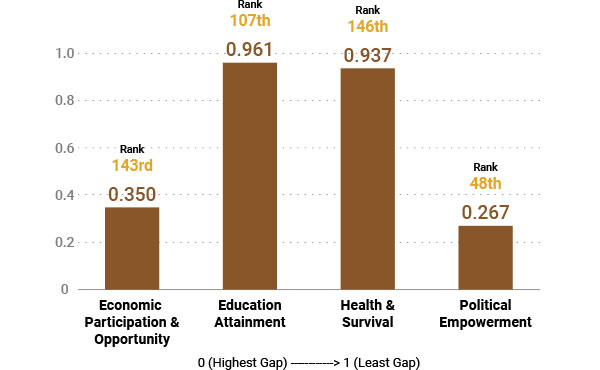
The World Economic Forum (WEF) released its sixteenth edition of the Global Gender Gap Report this week. The report covers over 146 countries and is designed to measure gender-based gaps in access to resources and opportunities which is plotted on the Gender Gap Index. In its latest edition of the index, India is ranked 135th amongst 146 countries placing it 2 positions below Malawi and 13 positions below Nigeria.

India has so far successfully closed only 62.9% of its gender gap based on its score of 0.629 in the Global Gender Gap Report 2022. In comparison to 2013, India's gender gap has widened further by 2.6 percentage points in 2022. This means that women are disadvantaged compared to men in India by 37.1% in 2022. India’s overall score of 62.9% is also lesser than the global average of 68.1%. Since 2013, India's gender gap has remained between 62-68% signifying not much progress has been made in gender equality over the last 9 years.
Performance Indicators
The report's Gender Gap Index ranks countries according to the calculated gender gap between women and men in four key areas to gauge the state of gender equality in a country.
- Economic Participation and Opportunity
- Education Attainment
- Health & Survival
- Political Empowerment

Economic Participation
This indicator factors access to women's representation in the labor force, access to equitable wages and high-skilled environment. India is currently ranked 143rd amongst 146 countries in Economic participation and Opportunity, with only Iran, Pakistan, and Afghanistan below it.
The gender gap in the economic participation and opportunity for women in India is in a state of continuous decline and is at its second-lowest level since 2013. India has so far managed to close only 35% of the gender gap in economic participation and opportunity. This effectively means that women are at a 65% disadvantage compared to men in access to equal work opportunities and participation in the nation's economic activity. Some of the areas adversely impacting the scores are women's representation in the country's labour force and the participation of legislators and senior managers.
Education Attainment
This indicator factors women's access to basic and high-level education thereby equipping new generations with the skills of the future to participate in and contribute to the economic development of their countries.
India is currently ranked 107th amongst 146 countries on Education Attainment, 1 position above Rwanda and 3 positions below Ghana. India has so far managed to close 96.1% of the gender gap in education attainment. This effectively means that women are at a 4% disadvantage compared to men in access to basic and high-level education. Some of the areas adversely impacting the scores are women's literacy rate and enrollment in secondary education.
Health & Survival
This indicator factors life expectancy and sex ratio. India is currently at the bottom of the index among 146 countries on Health & Survival. India has so far managed to close 93.7% of the gender gap in health & survival.
Political Empowerment
This indicator factors representation in political decision-making. India is currently ranked 48th amongst 146 countries on Political Empowerment.
The gender gap in the political empowerment of women in India is at its lowest level since 2013. India has so far managed to close only 26.7% of the gender gap in political empowerment. This effectively means that women are at a 73.3% disadvantage compared to men in political decision-making. Some of the areas adversely impacting the scores are women's representation in the parliament, and women in ministerial positions.

In comparison to other countries, the gender gap in India is lesser than that in Pakistan, Iran, and Afghanistan but higher than in countries like Ghana, Bangladesh, Nepal, Comoros, and the UK. India’s overall score on the Gender Gap Index 2022 is also lesser than the world average of 0.681.
| Also read: Global Gender Gap Index statistics and expert analysis |
There has been a generational loss between 2020 and 2021 as the trends leading up to 2020 showed that the gender gap was set to close within 100 years. As per the Global Gender Report 2022, the world will take 132 years to achieve complete gender parity. South Asia will take the longest to reach gender parity, estimated at 197 years.
TO READ THE FULL ARTICLE

Get full access to the exciting content on The Mirrority by logging in
Support independent journalism
Even the very best of media houses in our country today are yielding to the pressure of click-bait journalism in order to survive. More than ever before, our country needs journalism that is independent, fair and non-pliant to the bureaucracy. Such journalism needs the support of like-minded readers like you to help us survive editorially and financially.
Whether you live in India or India lives inside you, help us continue to produce quality journalism with your contribution.
CONTRIBUTE
